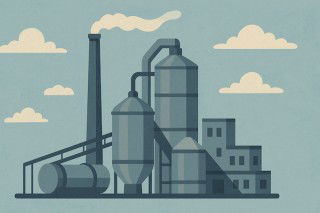The cement industry in the UAE is entering a transitional phase that will position the country amongst the highest producers and consumers of cement in the MENA region. The construction activity currently taking place in Dubai, and increasing signs of a shift in associated activity to Abu Dhabi and the other northern emirates are all drivers behind cement demand hikes witnessed over the past couple of years, and the expected continuation of momentum over the coming 3 to 5 years.
To date, information illustrates that cement grinding capacity will surge by ca. 37 per cent in 2007 and by an even higher ca. 51 per cent in 2008, settling at 35.4Mta, prior to leaping a further 14 per cent in 2009 to record 40.5Mta.
Clinker production capacity is meanwhile expected to grow at a higher rate in 2007 and 2008, pertaining to an approximate 56 and 64 per cent, respectively culminating at 25.5Mta, accordingly set to significantly reduce the nation wide deficit between cement production and clinker production to ca. 7.1Mta effective 2009.
Prime Research’s study believes once the severity of oversupply, region wide, becomes evident in 2008, this will prove sufficient to deter further Green fields at that time. Nevertheless a significant oversupply situation is left effective in 2008, pertaining to ca. 4.2Mt, increasing to ca. 8.1 million in 2009 and 2010, accordingly negatively effecting utilisation rates and production volumes across the board. Moreover, a sustained declining price trend from the current AED275/t is expected, however maintained prices at above AED200/t, a benchmark figure provided by industry players as the level at which Greenfield players would be forced out of the market.
The 3 largest listed cement players within the local market, in terms of market capitalisation, two of which, Gulf Cement and Union Cement, appear better set to weather the upcoming storm than the 3rd, National Cement. They are all integrated facilities, and command a cumulative ca. 31 per cent and ca. 37 per cent of aggregate domestic cement and clinker capacities based on our year end estimates.
Current market shares however will change drastically, as Union Cement undergoes massive expansion which will position it as the largest local player, with an expected cement production capacity of 4.6Mta in addition to 4.5Mt of clinker by November 2006. Gulf Cement is also in its final stages of expansions, which began in 2005, with the addition of a fourth mill to increase cement grinding capacity to 2.5Mta. The company’s new clinker kiln will be ready for production by year end, thus raising their clinker production capacity to 3.6Mta. National Cement alternatively has no upcoming expansion plans to date, subsequent to its recent kiln modification which increased clinker capacity from 0.73Mta to 1.15Mta. (Prepared by Prime Research).
